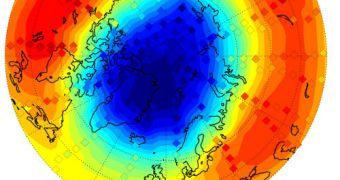Experts measuring the ozone concentrations above the northern hemisphere have determined that the precious chemical has reached record-low levels. This is especially true over northern Europe and the northern sector of the Atlantic Ocean.
The readings were collected using the Envisat satellite, which was designed and launched by the European Space Agency (ESA). According to weather experts, the polar vortex may be responsible for this situation.
The polar vortex is a set of strong winds, which usually circle the Arctic. This year, the cold air that loomed over the North Pole was trapped there, and prevented from mixing with warmer air at mid-latitudes, as is usually the case.
This led to excessively-cold weather, whose properties resembled those of winter in the southern hemisphere, above Antarctica. In a new paper, ESA scientists detail the chemical process that depleted the ozone layer in the Arctic.
They say that the cold air mass trapped above the North Pole began being struck by more and more sunlight as spring in the northern hemisphere began. This led to the release of ozone-damaging gases such as chlorine and bromine.
These substances come from a class of chemicals known as chlorofluorocarbons (CFC), the same gases that were forbidden internationally under the Montreal Protocol. CFC can easily destroy ozone, by converting it into individual oxygen molecules.
This happens at an altitude of about 20 kilometers, in the lower stratosphere. Ozone usually exists in large concentrations at altitudes of about 25 kilometers, where they act as a filter against the ultraviolet (UV) component of sunlight.
These radiations can easily harm marine life, as well as humans. Exposure to UV light has been linked to an increased incidence of cataracts and a variety of skin cancers. It is widely believed that life on Earth could have not evolved had it not been for the ozone layer.
“In a changing climate, it is expected that on average stratospheric temperatures cool, which means more chemical ozone depletion will occur,” explains University of Bremen expert Mark Weber.
“On the other hand, many studies show that the stratospheric circulation in the northern hemisphere may be enhanced in the future and, consequently, more ozone will be transported from the tropics into high latitudes and reduce ozone depletion,” adds the German investigator.
“Measurements from the Envisat’s Sciamachy, MIPAS and GOMOS instruments are providing unique ozone information that is important in enabling scientists to separate chemical and dynamical changes and helping to identify the influence of climate change on the stratosphere,” he adds.
“It is, therefore, essential to keep these instruments measuring for as long as possible,” Weber concludes.

 14 DAY TRIAL //
14 DAY TRIAL //